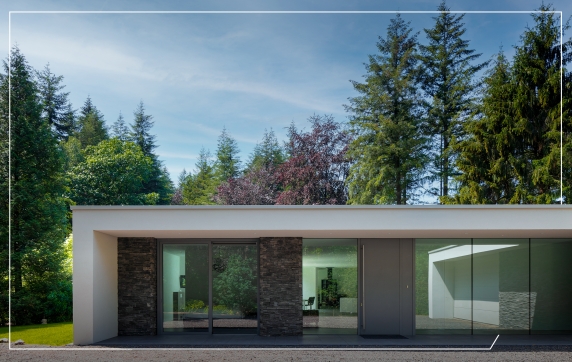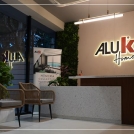In 2025, aluminium systems for low-carbon interiors are gaining significant momentum as India accelerates its push toward sustainable construction.
With mounting pressure to reduce embodied carbon, the energy-efficient aluminium windows are becoming a must! To address embedded emissions, architects are reevaluating material choices, such as recyclable aluminium building materials, to align with climate goals.
Considering everything, Aluminium stands tall as a preferred solution, not only for its modern aesthetics but also for its exceptional durability, lightweight nature, performance, and recyclability. Such qualities make this material an ideal choice for circular design strategies and long-term environmental performance.
Additionally, its low maintenance and compatibility with energy-efficient systems enhance its value proposition.
Aluminium systems are no longer an option, as they have become essential for creating interiors that are adaptive, climate-resilient, and future-ready.
Here, we emphasize the importance of sustainable interiors with aluminium. With this perspective, we proceed further.
Sustainability in Focus
We are all aware of the fact that the planet needs our help, and that's exactly what "Sustainability in Focus" is all about.
It's a way of highlighting the amazing ideas and actions that are contributing to making our world a healthier place. This is more than a trendy buzzword; it’s a promise to build a future where we can all prosper without depleting the resources of future generations.
From new ways to load our homes with wise choices about how we make things, this is about celebrating the solutions that are creating a greener and stronger world. It’s about making a conscious choice to live and work in harmony with nature, so the Earth stays lively for everyone.
Performance Meets Aesthetics
When we discuss performance in aluminium systems for low-carbon interiors that also meet aesthetic requirements, we are addressing a key demand of every Indian home..
For Indian architects, aluminium systems are a perfect fusion of form and function. They're not only a key component for low-carbon interiors but also a medium for creative expression.
Aluminium's inherent malleability enables it to be formed into a wide range of custom high-performance systems. It allows architects to design sleek, minimalist profiles for windows, doors, and facades that are both visually stunning and structurally sound.
This design flexibility, when combined with practical benefits such as being lightweight, durable, and highly corrosion-resistant, is crucial for India's complex climate conditions.
Such a blend of elegance and resilience stamps a building that looks great and performs efficiently for decades with unwavering reliability. Performance-friendly systems reduce maintenance interventions, while also being a choice that uplifts a project's style without compromising its sustainable integrity.
So, if you’re looking to achieve such performance-wrapped designs with an appealing factor, then AluK experts are here to help!
Innovation & Tech Integration
As low-carbon design trends emerge in India, so do the restructuring and technical integrations.
Innovation and digital infusion are transforming how Indian architects use aluminium for low-carbon interiors. The focus is on using such technological advancements to make the material itself more sustainable. This includes expansions in the shaping of aluminium profiles, enabling the creation of intricate and lightweight profiles with minimal waste.
This allows architects and manufacturers to simulate and optimize every microscopic detail. It involves precisely monitoring energy consumption and identifying potential material errors before they even occur.
Trends & Market Insights
When the talk is about aluminium systems for low-carbon interiors, it’s a significant trend among Indian architects in 2025. It’s something which is driven by both global market insights and local demands for sustainable building.
A key trend is the increasing consumer awareness and thumbs up for green buildings. It’s creating a strong market for eco-friendly or green construction materials for architects. As India's construction sector is booming, demand for lightweight, durable, and recyclable materials, such as aluminium, is surging.
Moreover, architects are also making the most out of market trends toward modular and pre-designed construction, where aluminium systems excel.
Our unitised curtain walling systems offer faster project timelines and reduce onsite waste on a massive scale. With government initiatives and green building certifications becoming more prevalent, specifying aluminium is a strategic move. It’s a calculated manoeuvre that aligns projects with these new industry standards, making them more attractive and future-proof in a quick-moving market.
Want to know more about trends and market insights? Call us now!
Also, read: Exploring the Role of Aluminium Systems in Smart City Development.
Case Examples & Projects
Indian architects are increasingly specifying aluminium systems for low-carbon interiors, and so are AluK Home’s experts due to their key role in sustainable design.
Aluminium is 100% recyclable and contributes to a circular economy, significantly reducing a project's carbon footprint.
These systems also improve building energy efficiency through thermal break technology. It further minimizes heat transfer and lowers the need for air conditioning, which leads to reduced operational energy consumption. The durability and low maintenance requirements of this material further extend its lifecycle, aligning with long-term sustainability goals.
Case Examples:
- Nirlon Knowledge Park in Mumbai, featuring AluK high-performance aluminium systems for its façade, showcases the material's role in large-scale, energy-efficient commercial projects.
- The New Light residential development in Mumbai also utilized Aluk’s aluminium systems for windows and doors, chosen for their durability and thermal efficiency in a coastal environment. These projects demonstrate how architects are selecting aluminium to achieve both aesthetic appeal and a commitment to a low-carbon future.
Practical Tips for Architects & Designers
In this section, you’ll see some hands-on suggestions for architects & designers. It will provide them with a roadmap for successfully integrating aluminium systems into low-carbon projects.
Have a look at the following actionable advice:
1. Specify Materials
Selecting aluminium systems thoughtfully can significantly reduce a project’s embodied carbon. This approach directly supports a planet-friendly economy while lowering the energy required for producing new raw materials.
2. Utilize High-Tech by Optimizing Designs
Optimize designs to leverage aluminium's thermal properties, such as using systems with integrated thermal breaks to reduce a building's energy consumption. You can further enhance it by incorporating these systems with contemporary technologies to automate climate control, thereby maximizing energy savings.
3. Design for Disassembly
Plan for the future by choosing systems that can be easily dismantled and reused, supporting a circular economy. This approach minimizes waste and preserves the inherent value of materials, reducing the need for new raw material extraction.
4. Integration is the Key
Integrate these environmentally friendly designs with other green technologies, energy-efficient HVAC systems and intelligent building controls.
All in all, these tips help professionals translate sustainability principles into tangible, high-performance, and aesthetically pleasing solutions that meet the demands of modern Indian construction.
Would you like to know more tips on these systems? AluK experts are here at your service!
Conclusion
Aluminium systems for low-carbon interiors are the request of many! These systems represent a pivotal intersection of innovation and market demand.
As India's construction sector moves toward more uncompromising sustainability targets, these systems provide a practical and strategic advantage. Their seamless integration of advanced technology demonstrates a commitment to operational efficiency and energy reduction.
This transformation reflects a growing professional consensus that a building's success is measured not only by its aesthetics, but also by its environmental performance, which plays a dominant role.
On the whole, choosing aluminium systems for low-carbon interiors is a forward-thinking decision that future-proofs projects, aligns with global green standards, and solidifies a project's long-term value.
Want to know why people are more attracted to aluminium systems for low-carbon interiors? Talk to our professionals now!
FAQs
Q1: Why are Indian architects increasingly choosing aluminium for low-carbon interiors?
Indian architects are specifying aluminium systems because they are a highly sustainable material. Aluminium is 100% recyclable, has a long lifespan, and when used with thermal breaks, it significantly improves a building's energy efficiency.
Q2: How does aluminium contribute to a building's energy efficiency?
Aluminium systems, particularly those with a thermal break, minimize heat transfer between the interior and exterior. This reduces the need for air conditioning, lowering a building's overall energy consumption and operational carbon emissions.
Q3: Is specifying aluminium for green interiors more expensive?
While green building materials can sometimes have a higher initial cost, aluminium systems provide significant long-term savings. Their durability and energy-efficient properties lead to reduced maintenance costs and lower utility bills from a decrease in air conditioning usage, making them a wise long-term investment.
Q4 How is India advancing towards low-carbon aluminium production?
India is making strides in low-carbon aluminium through initiatives like improving recycling practices, adopting energy-efficient production technologies, and integrating renewable energy sources. These efforts are helping create aluminium solutions that are both sustainable and high-performing, supporting a greener future for the construction and interiors sectors.
Q5 How do these systems fit with other sustainable design trends in 2025?
Aluminium systems are integral to several key trends. They complement biophilic design by allowing for large glass facades that connect interiors with the natural world. They also work seamlessly with smart building technology, as their lightweight and modular nature makes it easy to integrate sensors for automated lighting and ventilation, creating a holistic, high-performance interior.



